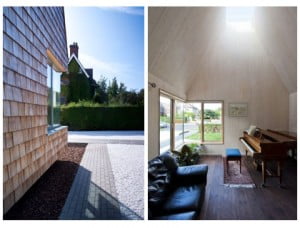A feature in December’s issue of the CIBSE journal suggested that biomass boilers contribute to carbon reduction, but AECB members Sofie Pelsmakers and Kate de Selincourt take issue with this. They argue that since DECC itself now admits biomass is not always low carbon, we should also accept reality, and recognise that targets and subsidies for biomass increase emissions and undermine the drive for truly efficient buildings.
THE December 2012 issue of the CIBSE journal ran an article highlighting several design and health and safety issues associated with the specification of biomass plant.[1] The article also made it clear that the main drive for installing biomass boilers is because of biofuel’s supposed ability to provide low-carbon heat.
However, the notion that biomass is automatically low-carbon is increasingly being challenged. [2] So a fundamental question is whether we should be heating our buildings with biomass at all?
Biomass produces very large quantities of CO2 per unit energy when burned (higher than gas or oil)[3], and any notion that the fuel is low-carbon depends entirely on re-uptake of CO2 through subsequent biomass growth. But the long delay before this happens, and the immediate reduction in growth when trees are felled and replaced with seedlings, means that a large and long-lasting pulse of CO2 is emitted for each kWh of biomass heat produced.
DECC themselves have admitted that because of this, using whole trees to fuel production of heat or electricity is a higher carbon option than leaving the trees to grow in the forest, and producing the energy by burning fossil fuels. This is true for at least 100 years after the energy is produced, and DECC concludes: “The use of harvested wood from UK managed forests exclusively for bioenergy (replacing fossil fuels) has higher relative GHG emissions than leaving the trees unharvested in the forest. This means that on the basis of GHG emissions, there is not a strong case to produce bioenergy in this way.”[4]
Burning offcuts and residues leads to equally high carbon emissions in the short term. Although the “debt” may be made up more quickly, there are still unwanted excess CO2 emissions over decades.[5]
While DECC suggested that using the whole harvest is not anything to worry about because “such a scenario is very unlikely in the UK ”, it is already happening. For example at a new wood pellet plant in Ayrshire, wood waste is used to power a pelleting process – but the pellets themselves are made from the logs. Overseas pellet producers also use the entire harvest.[6]
DECC has recently consulted on introducing GHG targets for biomass fuel, supported under the Renewables Obligation and Renewable Heat Incentive, but they only look at processing emissions, generally lower than those from combustion. There is nothing in the proposed GHG analysis that accounts for the emissions at combustion or the predicted speed of carbon re-uptake. This means that there is no certainty that the biomass receiving these susidies, burned in the UK is lower-carbon than its fossil fuel alternatives – and on a 20-year timescale, much will be as high-carbon as coal.[7]
Because biomass combustion emissions are ignored, stakeholders are lulled into complacency about emissions and energy use. When a biomass boiler is specified to meet a carbon target, attention tends to be diverted from fabric efficiency, because the design team (and client) may believe “the heat is all zero carbon anyway”. The unintended result is that CO2 emissions are the same as or higher than a conventional building, when they could have been greatly reduced by optimising energy demand.[8] Of course if as reported by CIBSE, boilers are frequently operating well below optimum efficiency, emissions will be higher still.
This situation is exacerbated by the policies of local and national government. Many local authority planning departments specify a certain percentage of on-site renewable energy in a bid to meet sustainability and/or carbon objectives. Yet, aside from buildings having to adhere to minimum Building Regulation fabric standards, there are no requirements to exceed such basic building efficiencies nor to optimise layouts for solar gain, etc.
National policies that offer subsidies for renewables and biomass heat (through the Renewable Heat Incentive for example), while offering no equivalent incentive for building efficiency, only serve to worsen the situation and actively undermine the necessary ‘fabric-first’ approach.

If for example you decide to install biomass heating in an old building, then any building efficiency measures start to look uneconomic, because you would lose the RHI subsidy on the energy you save. The subsidy means energy you could save does not cost much to waste, because the subsidy artificially depresses the price. It therefore takes the same fabric energy efficiency measures a lot longer to pay for themselves, where the RHI is available.
For any project there is likely to be a fairly fixed capital budget, and RHI payments mean that there can be a proportionally higher return on investment for spending the money on a biomass boiler, as opposed to making the same investment in fabric efficiency.
The net effect is a state subsidy for CO2 emissions that are much higher than they would have been from a truly efficient building, and sometimes higher even than a conventional one powered by fossil fuels.
Unfortunately, prioritising fabric efficiency over renewable generation is not in accordance with much planning policy; nor has it historically been incentivised by government; instead there is a misplaced focus on active systems for on-site energy supply, leading to inappropriate strategies, and buildings that are not as sustainable – and not as comfortable or cheap to run – as they could and should have been.
Under the circumstances, it is possibly just as well for the planet that some of these biomass boilers, specified mainly to meet these inappropriate requirements, are never even commissioned. But joking apart – what a waste of resources!
This is a massive lost opportunity for local and national governments, and for client and design teams, to deliver better buildings on the same budget. Increased fabric efficiency would have led to genuine CO2 reductions, lower energy costs and better energy security over the life-time of the building – whatever the fuel.
All this evidence suggests that biomass cannot and should not be counted on to cut the UK’s carbon emissions, and to suggest otherwise is misleading. If it has to be used at all, as a high-carbon fuel, biomass should only ever be utilised in buildings which have a very low heating demand. And it will be the efficiency of the fabric, not the choice of fuel, which determines any carbon reduction.
Trees are much too precious to burn: locking CO2 in trees or in timber building materials for decades (and even centuries) is by far the best and most robust low-carbon biomass strategy any designer and government can and should undertake.
“OK, I get the carbon argument. I’ve even convinced my client, but they’re a bit sad because they thought wood-burning was clean, green and eco. Isn’t it?”
Well, there is more:Biomass smoke is dirty: We’ll leave it to DECC and the US EPA to summarise the issue:
“The most significant air quality impacts from biomass stem from particulate matter (PM10) and oxides of nitrogen (NOx) emissions… The levels of PM and NOx in the UK are relatively high when measured against European Directive targets and the UK seeks to reduce these levels to avoid infraction. […] Air quality impacts depend on the size of the biomass installation.” [9]
“Fine particles are easily inhaled deep into the lungs… Scientific studies have linked particle pollution, especially fine particles, with …significant health problems, including: premature death in people with heart or lung disease; nonfatal heart attacks; irregular heartbeat; aggravated asthma; decreased lung function, and increased respiratory symptoms…. Particle pollution can cause coughing, wheezing, and decreased lung function even in otherwise healthy children and adults.”[10]
Bought biomass is often oven dried! Cultivating, harvesting, processing and transporting wood chips or wood pellets increases their environmental impact and greenhouse gas emissions. Processing, then shipping pellets from overseas (eg from the southern USA or Brazil) is responsible for emissions of a quarter to a half of those from fossil fuels, before you even put a match to them. [11]
The more we burn the more we will import: Relying on a local biomass supply for heating in the UK is wishful thinking: if all UK arable land available for growing of non-food crops (around 1 million hectares) [12] were cultivated for biomass, it would still only meet the hot water and space heat demand of around 10-15% of the current housing stock[13] – and that’s before you have started feeding commercial biomass boilers, and biomass power stations. The Climate Change Committee added up EU woody biomass fuel ambitions, and found there wasn’t enough spare biomass in the whole world to meet them.[14]
Imported biomass may lead to land grabs and hunger: Importing biomass from abroad raises significant ethical issues where tropical rainforest or agricultural land for food-growing has been or will be cleared for fuel crops to heat buildings in faraway regions. Biomass crop growing is land intensive and its mono-culture is unsupportive of local biodiversity.
Sustainability standards can’t guarantee anything: DECC is proposing to introduce “sustainable sourcing” criteria for biomass supplies for both heat and electricity generation.[15] However, the criteria only require 70% of each consignment to meet any standards at all, and they can be signed off by an agent employed by the fuel supplier.[16] Even the ‘best in class’ Forest Stewardship Council has had its standards called into question. [17]
Biomass is bulky: without biomass there would be more space available: biomass requires a storage area of 1.5 m3- 6m3 even for a single dwelling, based on a biomass delivery every 3 months [18].
This is an expanded version of a column published in the February issue of the CIBSE Journal http://cibsejournal.com/
Images: Cavendish by Mole Architects – http://www.molearchitects.co.uk/ Photographs by David Butler
© 2013: Sofie Pelsmakers, Kate de Selincourt and AECB (for Terms and Conditions click here)

Sofie Pelsmakers is author of The Environmental Design Pocketbook, co-founder of Architecture for Change and doctoral researcher at the UCL Energy Institute. www.environmentaldesignpocketbook.com

Kate de Selincourt is a writer and editor with an interest in sustainable building and the environment.
Continue the conversation – please post your response to this Soapbox on the AECB forum here. (AECB members only – please ensure you are logged in).
[1] http://www.cibsejournal.com/archive/2012-12/cover see p 22
[2] ‘Dirtier than Coal’ http://www.rspb.org.uk/Images/biomass_report_tcm9-326672.pdf
[3] http://www.manomet.org/sites/manomet.org/files/Manomet_Biomass_Report_Full_LoRez.pdf
[4] http://www.decc.gov.uk/assets/decc/11/meeting-energy-demand/bio-energy/7014-bioenergy-strategy-supplementary-note-carbon-impac.pdf
[5] See for example http://www.tandfonline.com/doi/abs/10.1080/02827581.2011.615337
[6] See http://www.laganconstruction.com/wood-pellet-biomass-plant-successfully-completed/, www.theclaymoreproject.com/uploads/associate/151/file/Low carbon wood pellet production.pdf (sic) and for overseas pellet production, http://www.dogwoodalliance.org/wp-content/uploads/2012/11/Whole-Tree-Wood-Pellet-Production-Report.pdf and http://www.ewg.org/agmag/2010/06/did-they-really-say-that-see-for-yourself/
[8] http://ww.aecb.net/UserFiles/File/Biomass_A_Burning_Issue_September_2010.pdf
[9] https://www.gov.uk/government/uploads/system/uploads/attachment_data/file/43168/5886-ia-air-quality-rhi-cons.pdf
[10] http://www.epa.gov/pm/fastfacts.html
[11] http://www.environment-agency.gov.uk/static/documents/Research/Minimising_greenhouse_gas_emissions_from_biomass_energy__generation.pdf
[12] Energy Savings Trust (2010), Domestic Low and Zero Carbon Technologies, p.20.
[13] Estimates based on Energy Savings Trust (2010), Domestic Low and Zero Carbon Technologies, p.20.
[14] http://www.theccc.org.uk/reports/bioenergy-review
[15] http://www.decc.gov.uk/assets/decc/11/consultation/rhi-certainty-performance/5883-rhi-certainty-performance-cons.pdf
[16] Sustainable Biomass – a Modern Myth http://www.biofuelwatch.org.uk/2012/biomass_myth_report/
[17] http://www.naturskyddsforeningen.se/sites/default/files/dokument-media/rapporter/2013_engelsk_rapport_skog_credibility_at_stake.pdf
[18] Storage volumes are based on deliveries every 3 months and depend on biomass fuel; dwelling size and heat demand. Storage areas need to be larger if fewer yearly deliveries and/or if low fabric energy-efficiency. http://www.scotland.gov.uk/Resource/0038/00387492.pdf and Pelsmakers, The Environmental Design Pocketbook, RIBA Publishing, 2012, p351-359
